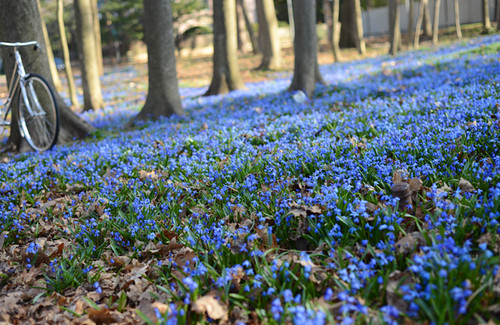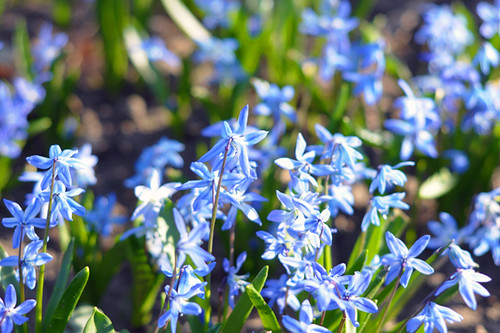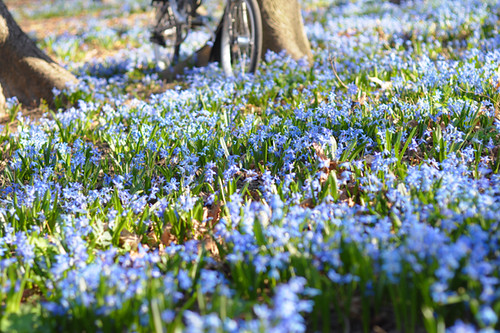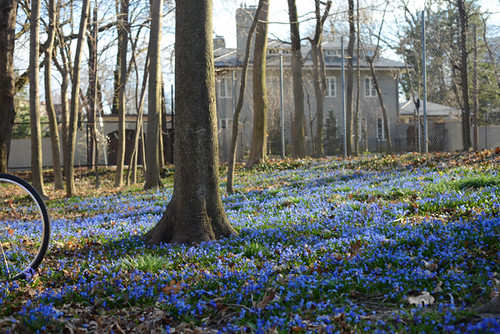Our Enchanted Blue Forest
Every April, some of my bicycle photos feature a background of what appears to be a carpet of blue flowers. Readers ask all the time what those flowers are and where I managed to find an entire field of them. Funny, until about 4 years ago I do not remember seeing many of these around myself. Then one spring - my first spring of cycling - I was riding around the neighbourhood and discovered a patch of them on a lawn. It caught my eye, because the shade of blue seemed unnaturally over-saturated. From a distance it looked like someone had spilled cerulean paint on the grass! Later I spotted another small patch of the same flowers in a nearby park, and again marveled at the effect. I meant to investigate further, but a week later the flowers were gone. I did not think of them again, until the following April, when they reappeared in much larger quantities. Now the lawn where I had spotted the first patch was covered with them completely. The ones in the park had spread over a wider area as well.
When I stopped to examine the flowers closely, I saw that individually they were not remarkable or even especially pretty. Scraggly tiny things with long, misshapen, sharply pointed petals. It was hard to find one photogenic enough to photograph on its own, and large enough to capture without a macro lens.
Their beauty came from growing in clusters. When they cover a patch of soil, all those tiny blooms merge into a quivering sea of blues and greens of incredible intensity. The larger the area they spread across, the more mesmerising and overwhelming their effect.
By the third year, they'd spread further still - spilling over to multiple lawns all over the neighbourhood, and transforming the small fenced-in park near my house. Finally I learned what the flowers are. Rather unromantically, they are called wood squills. Also known as Siberian squill, or Scilla siberica - a "bulbous perennial in the family Asparagaceae." The flowers produce blue pollen, which may explain their misty, hazy quality when observed from afar. Easy to cultivate, they spread by seed and form large colonies in early spring that bloom quickly and disappear by the time the first growth of grass is ready to be mowed.
Apparently Scilla siberica colonies can become invasive, and it looks like our little park has been invaded! Even this year's cold, slow spring has not stopped the squills from covering the entire stretch of the woods in cerulean carpet, turning the park - a popular pedestrian shortcut for locals - into an enchanted blue forest. Walking through here is absolutely stunning. One of those sights that makes you breathe in deeply, squint at the sun, and just feel happy to be a part of this strange, beautiful world.






They are beautiful! I'll have to see if I can find any to plant around me. Thanks for letting us know what they are called.
ReplyDeleteUnless you're in Siberia, please don't plant any. They're an invasive species.
DeleteThanks!
Ahparantly they aren't native to Siberica and are rapidly invading the Midwest.
DeleteA noted biologist-friend, whenupon I asked him what the difference was between a plant and a weed, replied, "Good question. I suppose a weed is something man does not want."
From beauty to scourge, 'tis a fine line.
You could always roast these Asparagaceae with some evoo tho.
You're right; not Siberia, but SW Russia, Turkey, and the Asia/Europe border areas. Absolutely NOT originally from N.America, although they have already invaded.
DeleteThe fine line, I think, is more between being part of the problem or part of the solution. Let's not deliberately plant more invasive flowers; find some pretty indigenous flowers, and plant those.
Aesthetes don't think in those terms, y'know.
DeleteI meant "botanist" above. Bloody hell.
All about non-invasive plants here.
@Screech is correct. Please do not deliberately plant invasive flowers or plants. The book 'Bringing Nature Home: How You Can Sustain Wildlife with Native Plants' by Douglas W. Tallamy gives an excellent argument for native plants.
DeleteInteresting stuff. I am clueless when it comes to gardening. I need a yard.
DeleteInvading the Midwest? It's been a 50 year invasion at least from personal observation.
DeleteGorgeous! Thank you for taking the time to still write posts like this one, and the one you did about the tree house some months ago. It absolutely makes my day!
ReplyDeleteRuth
Thanks for the reminder, I should go visit there again.
DeleteBeautiful contrast to yesterday's post?
ReplyDeleteThat's how it goes. Though I'd planned the blue flower post in advance.
Deleteluv!
ReplyDeleteI wouldn't mind if they invaded my yard. They can take over if they like!
ReplyDeleteWhat gorgeous ground-cover. It reminds me of the endless acres of bluebells in the forests of England in the springtime!
ReplyDeleteCheers, Velouria!
Thank you for telling us how they spread. I thought they did by producing new bulbs. I`ll take a tiny brush and help them this spring, not enough insects to create carpets here I guess. Spring is later here though.
ReplyDeletebadmother
This reminds me of a beautiful field of purple that I saw on my century ride this past weekend. I think it may have been clover.
ReplyDeleteUnfortunately, I was at a point in the ride where I wasn't too eager to get off the bicycle, so I just snapped a couple shots as I rolled past. In hindsight I should have stopped and taken better pictures. Live and learn...
You'll just have to do the ride again!
DeleteIn my neck of the woods, folks use chemicals to prevent this kind of invasion....sad.
ReplyDeleteWithout going into lizards, it's the insects I don't understand. How do they get through the winter? A couple days of 73+ish F degrees and they are all over the place and in my face. No fuss, no muss for them. Really pisses me off.
ReplyDeleteIn the winter they stay indoors and use the trainer I imagine, poor things.
DeleteInsects live a rich life, pure and simple!
DeleteInsects either: a) hide underground below the frost; b) supercool, so that they get colder than freezing but don't actually freeze (freezing would kill them); or c) allow part of their body to freeze while keeping the insides of their cells from freezing.
DeleteWell, you did ask...
I recommend a trip to Mount Auburn Cemetery in Cambridge before these are done for the season — they make lovely little carpets under many of the beech trees there.
ReplyDeleteThese flowers appear to be imposters for the visual effect of woodland phlox, when blanketed across the forest floor. Phlox is native, and actually prettier (up close anyway).
ReplyDeleteTotally different colour and form than phlox, both flowers and stems, leaves, etc.
DeleteTrue all that, especially up close, but woodland phlox does carpet the forest floor in blue. A lighter but bluer blue.
DeleteI get what you're saying but disagree. Phlox=spring and delicate blues/purples in low lying form.
Delete
ReplyDeleteLeaves glowing in the sun, zealous hum of bumblebees,
From afar, from somewhere beyond the river, echoes of lingering voices
And the unhurried sounds of a hammer gave joy not only to me.
Before the five senses were opened, and earlier than any beginning
They waited, ready, for all those who would call themselves mortals,
So that they might praise, as I do, life, that is, happiness.
Czeslaw Milosz
Big fan of Milosz here - he used to be a neighbour and occasionally read at events.
DeleteNice addition.
I like how you include just a hint of bike to turn this into a Lovely Bicycle topic :) Stunning blues.
ReplyDeleteThat's absolutely beautiful, they will be invading the small lot in front of my shop soon!
ReplyDeleteThese plants have invaded our yard and neighbors' yards. We've been removing them individually by hand for the last 8-9 years or so and still haven't gotten all of them. They are a nuisance because they spread like a cancer. They are hardy as all get out and so difficult to contain once they've gotten a foothold onto your lawn. The bulbs "hide" hide under stones and in roots of trees or ferns growing in the yard. The plant seems almost indestructible - perfect for a nuclear blast. We compare them to cockroaches - both species will survive until the end of time. Please do not plant unless your plan is to wreck your yard and your neighborhood.
ReplyDelete